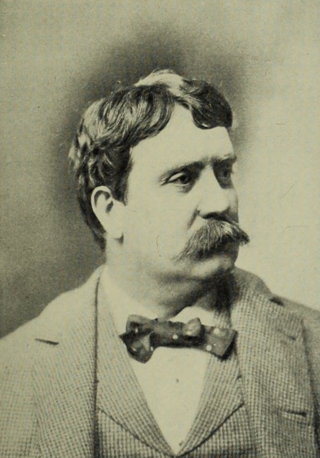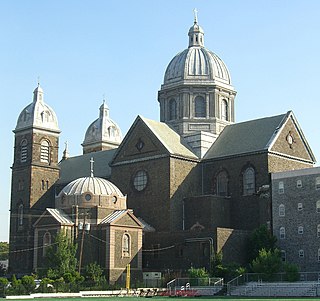Related Research Articles

Daniel Hudson Burnham was an American architect and urban designer. A proponent of the Beaux-Arts movement, he may have been "the most successful power broker the American architectural profession has ever produced."

Hudson County is the smallest and most densely populated county in the U.S. state of New Jersey. It lies west of the lower Hudson River, which was named for Henry Hudson, the sea captain who explored the area in 1609. Part of New Jersey's Gateway Region in the New York metropolitan area, the county seat is Jersey City, which is the county's largest city in terms of both population and area. The county is part of the North Jersey region of the state.

Union City is a city in the northern part of Hudson County, in the U.S. state of New Jersey. As of the 2020 United States census, the city was the state's 18th-most-populous municipality, with a population of 68,589, an increase of 2,134 (+3.2%) from the 2010 census count of 66,455, which in turn had reflected a decline of 633 (−0.9%) from the 67,088 counted in the 2000 census. As of the 2010 Census, among cities with a population of more than 50,000, it was the most densely populated city in the United States, with a density of 54,138 per square mile of land. The Census Bureau's Population Estimates Program calculated that the city's population was 65,366 in 2022, ranking the city the 590th-most-populous in the country.

George Browne Post, professionally known as George B. Post, was an American architect trained in the Beaux-Arts tradition. Active from 1869 almost until his death, he was recognized as a master of several prominent contemporary American architectural genres, and instrumental in the birth of the skyscraper.

Carrère and Hastings, the firm of John Merven Carrère and Thomas Hastings, was an American architecture firm specializing in Beaux-Arts architecture. Located in New York City, the firm practiced from 1885 until 1929, although Hastings practiced alone after Carrère died in an automobile accident in 1911.

The Lehigh and Hudson River Railway (L&HR) was the smallest of the six railroads that were merged into Conrail in 1976. It was a bridge line running northeast–southwest across northwestern New Jersey, connecting the line to the Poughkeepsie Bridge at Maybrook, New York, with Easton, Pennsylvania, where it interchanged with various other companies.

Vanderbilt Mansion National Historic Site is a historic house museum in Hyde Park, New York, United States. Designated a National Historic Landmark in 1940, it is owned and operated by the National Park Service.

Snake Hill is an igneous rock intrusion jutting up from the floor of the Meadowlands in southern Secaucus, New Jersey, United States, at a bend in the Hackensack River. It was largely obliterated in the 1960s by quarrying that reduced the height of some sections by one-quarter and the area of its base by four fifths. The diabase rock was used as building material in growing areas like Jersey City. The remnant of the hill is the defining feature of Laurel Hill County Park. The high point, a 203-foot graffiti-covered inselberg rock formation, is a familiar landmark to travelers on the New Jersey Turnpike's Eastern Spur, which skirts the hill's southern edge. The crest of the hill's unusual, sloping ridge is about 150 feet high.

Detlef Lienau was a German architect born in Holstein. He is credited with having introduced the French style to American building construction, notably the mansard roof and all its decorative flourishes. Trained at the École des Beaux-Arts, Paris, he designed virtually every type of Victorian structure—cottages, mansions, townhouses, apartment houses, hotels, tenements, banks, stores, churches, schools, libraries, offices, factories, railroad stations, and a museum. Lienau was recognized by clients and colleagues alike as one of the most creative and technically proficient architects of the period, and was one of the 29 founding members of the American Institute of Architects.

West Hoboken was a municipality that existed in Hudson County, New Jersey, from 1861 to 1925. It merged with Union Hill to form Union City on June 1, 1925.

John Cox Stevens was the founding Commodore of the New York Yacht Club. He was a member of the America syndicate which, in 1851, won the trophy that would become the America's Cup.

The Old Poughkeepsie YMCA is on the west side of Market Street near the corner of Church Street in Poughkeepsie in New York, United States, across from the former New York State Armory. One of many historic early 20th-century institutional buildings on Market Street, the city's main downtown thoroughfare, it has a glazed terra-cotta front facade, the only building in Poughkeepsie using that material.

Frederick Clarke Withers was an English architect in America, especially renowned for his Gothic Revival ecclesiastical designs. For portions of his professional career, he partnered with fellow immigrant Calvert Vaux; both worked in the office of Andrew Jackson Downing in Newburgh, New York, where they began their careers following Downing's accidental death. Withers greatly participated in the introduction of the High Victorian Gothic style to the United States.
Robert Siegel Architects is a New York City-based architecture firm that designs new buildings, renovations and interiors for a wide range of clients and programs. Their public, academic, cultural, commercial and residential projects are located throughout the United States, Korea, China, and Japan. The firms has a won 30 design awards and has appeared in over 50 publications.
The Beacon is a mixed-use development located on a 14-acre (57,000 m2) site on Bergen Hill, a crest of the Hudson Palisades and one of the highest geographical points in Jersey City, Hudson County, in the U.S. state of New Jersey. The Beacon, which occupies the Jersey City Medical Center's rehabilitated original complex, creates the northeastern corner of the Bergen-Lafayette section and is just east of McGinley Square. The Beacon includes 2,000,000 square feet (190,000 m2) of residential and retail space, approximately 1,200 luxury residences and 80,000 square feet (7,400 m2) of retail space.

The Monastery and Church of Saint Michael the Archangel, known locally as Saint Michael's Monastery Church, is a state and national historic place in Union City, New Jersey, United States. Formally opened in 1869 and completed in 1875, the grounds of the complex are bounded West Street and Summit Avenue between 18th and 21st Streets. The small street leading to its front entrance from the east is called Monastery Place. At one time the largest Roman Catholic church in Hudson County, it has since become home to a Presbyterian congregation while part of the grounds are used for housing and education. At one time its walls were adorned by artwork by Hildreth Meière, until rain damage prompted their removal from public view.
Samuel Juster, AIA, was an American architect who practiced during the mid-20th century in New York City and New Jersey.

John H. & Wilson C. Ely was a father and son architectural firm based in Newark, New Jersey responsible for some of the more prominent buildings built in the city in the early 20th century, many in the Classical Revival style.

Charles Alling Gifford was an American architect and a partner in the New York City firm of Gifford & Bates. He is best remembered for his resort hotels, but also designed houses, churches, and five armories for the New Jersey National Guard.
French, Dixon & DeSaldern was a prominent New York architectural firm that operated from 1890 to 1893 that designed many historically significant public buildings in New York and New Jersey, as well as several remote parts of the country. In 1877 Charles Abbot French began an architectural firm, named Chas A. French & Co, practicing at 200 W. 57th Street in Manhattan. Later, he merged with the Firm Dixon & DeSaldern of 17 Broadway, admitting Robert Campbell Dixon junior and Arthur De Saldern as partners to the firm in 1889, after Dixon and DeSaldern split with Thomas Stent in 1888. All three partners were natives of New York state. The firm French, Dixon & DeSaldern had offices located in The Rutland Building on 57th and Broadway, a well known building which their firm designed. The Rutland hotel was at the 256 W 57th Street, which is now the site of the Fisk Tire Building.
References
- 1 2 3 4 5 6 7 8 Harvey, Cornelius Burnham, ed. (1900). Genealogical History of Hudson and Bergen Counties, New Jersey. New York: The New Jersey Genealogical Publishing Company. pp. 136–137.
- 1 2 3 4 5 Feldra, Robert (1917). History of Hudson County: Genealogies of prominent families. Town of Union, NJ: Michel & Rank Publishers. pp. 52–53. Retrieved April 23, 2020.
- ↑ Directory of British Architects. Vol. 2 (L-Z). A&C Black. 2001. ISBN 082645514X.
- ↑ History and Commerce of New York - 1891 (2nd ed.). New York: American Publishing And Engraving Co. 1891. p. 174.
- ↑ "Landmarks Preservation Commission - NEW-YORK CAB COMPANY STABLE 318-330 Amsterdam Avenue, aka 201-205 West 75th Street, Borough of Manhattan" (PDF). Landmarks Preservation Commission. November 14, 2006. Retrieved April 23, 2020.
- ↑ Brown, Glenn (1908). Quarterly Bulletin Containing an Index of Literature From the Publications of Architectural Societies and Periodicals on Architecture and Allied Subjects from January 1, 1908 to April 1, 1908. The Octagon, Washington DC. p. 203.
{{cite book}}: CS1 maint: location missing publisher (link) - 1 2 3 4 5 "Chapter 9: Architectural Historic Resources". No. 7 Subway Extension—Hudson Yards Rezoning and Development Program Final Generic Environmental Impact Statement (PDF) (Report). Empire State Development. pp. 9–37. Retrieved April 23, 2020.